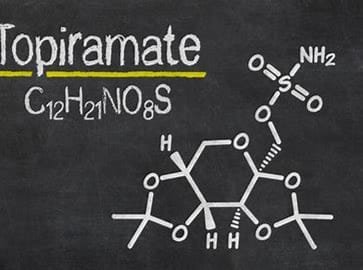Valproate and topiramate are among those most frequently prescribed drugs, particularly for disorders involving seizures and also some mood disorders.

1. Valproate Formation
Valproate, also known as valproic acid or sodium valproate, is a fatty acid derivative. The drug acts by increasing the levels of gamma-aminobutyric acid in the brain, an amino acid that tends to stabilize electrical activity. It is commercially available as tablets, capsules, and liquid, although sodium valproate is the most common preparation because it has been found to be better absorbed and more stable in solution.
Uses
Valproate is prescribed mainly for it has been used for the treatment of generalized tonic-clonic, absence, and myoclonic seizures of epilepsy, bipolar disorder mood stabilization, and for preventive treatment, especially for frequently recurring complicated migraine attacks that are active despite continuous neurologic antimigraine drugs.
Adverse Effects
Common: Gastrointestinal, Nausea or vomiting Weight gain, insomnia, drowsiness, fatigue,
Shakiness In worst cases, valproate can lead to liver disorder, pancreatitis, as well as fetal malformation if used when pregnant. It is normally not preferred for women in their age of childbearing unless it is the case in question.
Advantages
It is effective in treating diverse types of seizures.
Licensed for use both in epileptic conditions and mood-stabilizing therapy
It is readily available in a variety of forms, so dosages can be very flexible.
Disadvantages
Very dangerous side effects, notably liver and pancreas malfunction
Not for pregnant mothers since it harms the babies.
Weight gain and sedation are other side effects that may cause a lack of adherence.
2. Topiramate
Topiramate is manufactured by the brand name Topamax. It is not structurally related to valproate, and the action is based on an anti-abnormal electrical brain activity. It is supplied as tablets and sprinkle capsules, and topiramate is often used in addition to other drugs for optimal effect.
Indications
Epilepsy: Valproate is effective against partial-onset seizures, generalized tonic-clonic seizures, and Lennox-Gas taut syndrome, mainly in children.
Migraine Prophylaxis: Topiramate reduces the frequency and severity of migraines.
Bipolar Disorder (Off-Label): It is used adjunctively for mood stabilization, though it has not been approved by the FDA for this purpose.
Side Effects

Common side effects are:
cognitive effects, including memory lapses, confusion, and inattention (the so-called “dopamax” effect);
weight loss and decreased appetite
Tingling sensation in hands and feet
Mood changes and irritability More serious adverse effects are uncommon but include kidney stones and metabolic acidosis.
Benefits
It is particularly effective in seizure control as well as prevention of migraine.
The drug has the capability to induce weight loss and may be beneficial in select patients.
Preparations are available in a number of presentations to allow considerable flexibility in dosing.
Drawbacks
Cognitive adverse effects can be an annoyance and impair function, sometimes kidney stones as well as metabolic imbalances.
Contraindicated in pregnancy or avoided owing to potential danger to fetus
Valproate vs. Topiramate
Both have advantages for seizures and the prevention of migraines. Valproate has a more established role in mood stabilization and is utilized more broadly across seizure types. However, its more serious side effects potential for liver and fetal toxicity prevent its use in some populations. Topiramate could be a better option for those who would benefit from the weight loss, but the drawback can be the cognitive side effects.
Summary

These drugs, valproate and topiramate, have different profiles and may be an option for the patient with needs for epilepsy and migraine management. Patients and clinicians will need to consider the balance of benefit and risk so that treatment is tailored appropriately to the individual’s health needs and lifestyle preferences.



